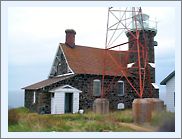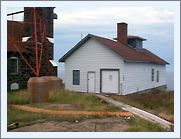|
Historical Information

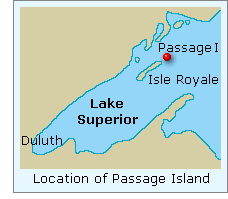 With increased mining of copper, nickel and silver along the north shore
of Lake Superior toward the end of the 1860's, the volume of vessel
traffic making its way through the area increased dramatically. With
many vessels making the deep-water passage between the northern tip of
Isle Royale and Passage Island, a scant three and a half miles to the
north, the Lighthouse Board determined that a light on the southern tip
of Passage Island was necessary to mark the deepest northern edge of the
channel. Realizing that the costs associated with construction at such a
remote and inaccessible location would be high, the Board requested an
appropriation of $18,000 for the construction of the station in its
annual report for the 1871 fiscal year. With no Congressional response,
the Board repeated the request in each of its annual reports for the
following four years. With increased mining of copper, nickel and silver along the north shore
of Lake Superior toward the end of the 1860's, the volume of vessel
traffic making its way through the area increased dramatically. With
many vessels making the deep-water passage between the northern tip of
Isle Royale and Passage Island, a scant three and a half miles to the
north, the Lighthouse Board determined that a light on the southern tip
of Passage Island was necessary to mark the deepest northern edge of the
channel. Realizing that the costs associated with construction at such a
remote and inaccessible location would be high, the Board requested an
appropriation of $18,000 for the construction of the station in its
annual report for the 1871 fiscal year. With no Congressional response,
the Board repeated the request in each of its annual reports for the
following four years.
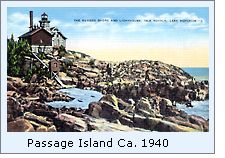 For some time, the Lighthouse Board had
been unsuccessfully attempting to convince the Canadian Government to
build a navigational aid on Colchester Reef in the Canadian waters of
Lake Erie to the east of the entrance to the Detroit River. Realizing
that the planned light on Passage Island would be of extreme advantage
to Canadian maritime interests in Lake Superior, on March 3, 1875,
Congress took the opportunity to apply some additional pressure on their
Canadian counterparts by taking the atypical step of authorizing that
the $18,000 be made available to the Lighthouse Board only upon the
completion of a light at Colchester Reef by the Canadians. For some time, the Lighthouse Board had
been unsuccessfully attempting to convince the Canadian Government to
build a navigational aid on Colchester Reef in the Canadian waters of
Lake Erie to the east of the entrance to the Detroit River. Realizing
that the planned light on Passage Island would be of extreme advantage
to Canadian maritime interests in Lake Superior, on March 3, 1875,
Congress took the opportunity to apply some additional pressure on their
Canadian counterparts by taking the atypical step of authorizing that
the $18,000 be made available to the Lighthouse Board only upon the
completion of a light at Colchester Reef by the Canadians.
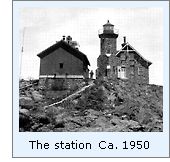 Since history shows that the Canadian
Government did not complete construction of the light on Colchester Reef
until 1885, we can only assume that Congress decided to release the
funds before the requirements of the contingency were met since the
$18,000 was released to the Lighthouse Board in 1880. Since history shows that the Canadian
Government did not complete construction of the light on Colchester Reef
until 1885, we can only assume that Congress decided to release the
funds before the requirements of the contingency were met since the
$18,000 was released to the Lighthouse Board in 1880.
The following summer, the Lighthouse
tender WARRINGTON delivered a working party and materials at Passage
Island, and work began at the site with the clearing of the grounds and
the construction of temporary dwellings for the workers.
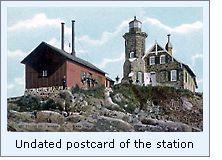 The plans for
the Passage Island Station called for a virtual duplicate of the
"Norman Gothic" style structure previously used at Chamber's
Island, Eagle Bluff, and McGulpin's Point, among others. The 26' x 30'
two-story fieldstone keepers dwelling featured an integral fieldstone
tower in its southwest corner. With a buttressed base 9' 4" square,
the tower transitioned to an octagonal plan above the second floor
level. A circular spiral cast iron stairway within the tower featured
landings on both the first and second floors, and served double duty as
the only stairs between the two floors and for access to the tower. The
ten-sided cast iron lantern, fabricated at the Lighthouse Deport in
Detroit and shipped to the site in sections, was reassembled atop the
tower. Finally, the fixed red Fourth Order Fresnel lens was carefully
assembled on its cast iron pedestal within the lantern. With a tower
height of forty-four feet, the light's location atop a rocky cliff at
the water's edge provided the lens with a seventy-eight foot focal
plane. The plans for
the Passage Island Station called for a virtual duplicate of the
"Norman Gothic" style structure previously used at Chamber's
Island, Eagle Bluff, and McGulpin's Point, among others. The 26' x 30'
two-story fieldstone keepers dwelling featured an integral fieldstone
tower in its southwest corner. With a buttressed base 9' 4" square,
the tower transitioned to an octagonal plan above the second floor
level. A circular spiral cast iron stairway within the tower featured
landings on both the first and second floors, and served double duty as
the only stairs between the two floors and for access to the tower. The
ten-sided cast iron lantern, fabricated at the Lighthouse Deport in
Detroit and shipped to the site in sections, was reassembled atop the
tower. Finally, the fixed red Fourth Order Fresnel lens was carefully
assembled on its cast iron pedestal within the lantern. With a tower
height of forty-four feet, the light's location atop a rocky cliff at
the water's edge provided the lens with a seventy-eight foot focal
plane.
 Finally, with the installation of a
1,500-pound fog bell with a Steven's clockwork striking
mechanism, work
at Passage Island was complete, and the light was exhibited for the
first time on the night of July 1, 1882. Finally, with the installation of a
1,500-pound fog bell with a Steven's clockwork striking
mechanism, work
at Passage Island was complete, and the light was exhibited for the
first time on the night of July 1, 1882.
The WARRINGTON delivered a
working party and materials to Passage Island in August 1884, tasked
with the construction of a steam-operated fog signal at the station. The
signal building was a frame structure on a plan being used throughout
the lakes at the time. Lined with smooth iron sheeting on the inside and
corrugated iron on the exterior, all spaces between the wall studs were
packed with sawdust and lime for insulation purposes. Twin boilers and
steam engines fed duplicate 10-inch steam whistles, which were located
within a cupola atop the structure's roof at the south end. Work on the
fog signal was finished on October 25, and the station was officially
placed in service. That first season, the 10-inch whistles were operated
for a total of 174 hours. While we can assume the Passage Island keepers
felt that they earned their pay that year, their efforts in attending
the fog-signal that year paled to those that followed in 1895, when they
shoveled 35 tons of coal to keep the whistles blaring their warning
across the lake for a total of 755 hours.
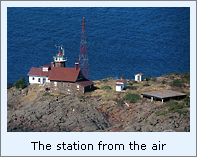 In 1898 it was decided that the
characteristic of the light needed to be modified to increase its
effectiveness, and the district Lampist arrived from Detroit with a new
flashing white lens manufactured by Barbier, Benard & Turenne of
Paris. Rotated by a clockwork mechanism, the keeper's were required to
keep the mechanism oiled, wound and adjusted to ensure that the lens
would rotate at exactly the right speed to conform to its' published
characteristic ten second flash cycle. In 1898 it was decided that the
characteristic of the light needed to be modified to increase its
effectiveness, and the district Lampist arrived from Detroit with a new
flashing white lens manufactured by Barbier, Benard & Turenne of
Paris. Rotated by a clockwork mechanism, the keeper's were required to
keep the mechanism oiled, wound and adjusted to ensure that the lens
would rotate at exactly the right speed to conform to its' published
characteristic ten second flash cycle.
The Passage Island station was
automated on December 20, 1978 with the installation of solar-powered electric bulb
within the Fourth Order Fresnel lens. However, the Fresnel was
completely replaced by a 190 mm acrylic optic in 1989, and the big lens
was transported to the Portage Coast Guard Station, where it was placed
on display in the station's lobby.
The Passage Island Light station still
serves as an active aid to navigation, and is now part of Isle Royale
National Park.

Keepers of
this Light

Click here
to see a complete listing of all Passage Island Light keepers compiled
by Phyllis L. Tag of Great Lakes Lighthouse Research.

Seeing this Light

We have yet to visit this light, and it is doubtful that we will be able
to arrange to do so for some time. We would like to take this
opportunity to thank Keith B. Kotimko for sharing the photographs
of the light station he took in June 2001.

Contact information

Isle Royale National Park
800 East Lakeshore Dr.
Houghton, MI 49931-1895
Tel: (906)482-0984
Email: ISRO_ParkInfo@nps.gov

Finding this
Light

The MV Sandy makes the trip to Passage Island on Mondays and
Fridays, departing from Rock Harbor at 1.30pm on both days. After
landing at Passage Island, a Ranger takes visitors along the trail to
the light station. The Sandy returns to Rock Harbor at 6.00pm. For
additional information, NPS Isle Royal website
has additional information on the various trips available throughout the
islands.

Reference sources

Annual reports of the Lighthouse Board, 1871 - 1909.
Great Lakes Light Lists - 1924, 1928, 1939 & 1953.
Great Lakes Coast Pilot No. 6, 2000.
Congressional Journals May 2 & May 9, 1872.
Photographs courtesy of Keith B. Kotimko.
Northern Lights, Charles K. Hyde, 1996
Email from Jeremy D'Entremont on Isle Royale transportation on 08/07/01.
US Coast Guard Historian's office.
Keeper listings for this light appear
courtesy of Great
Lakes Lighthouse Research
|

